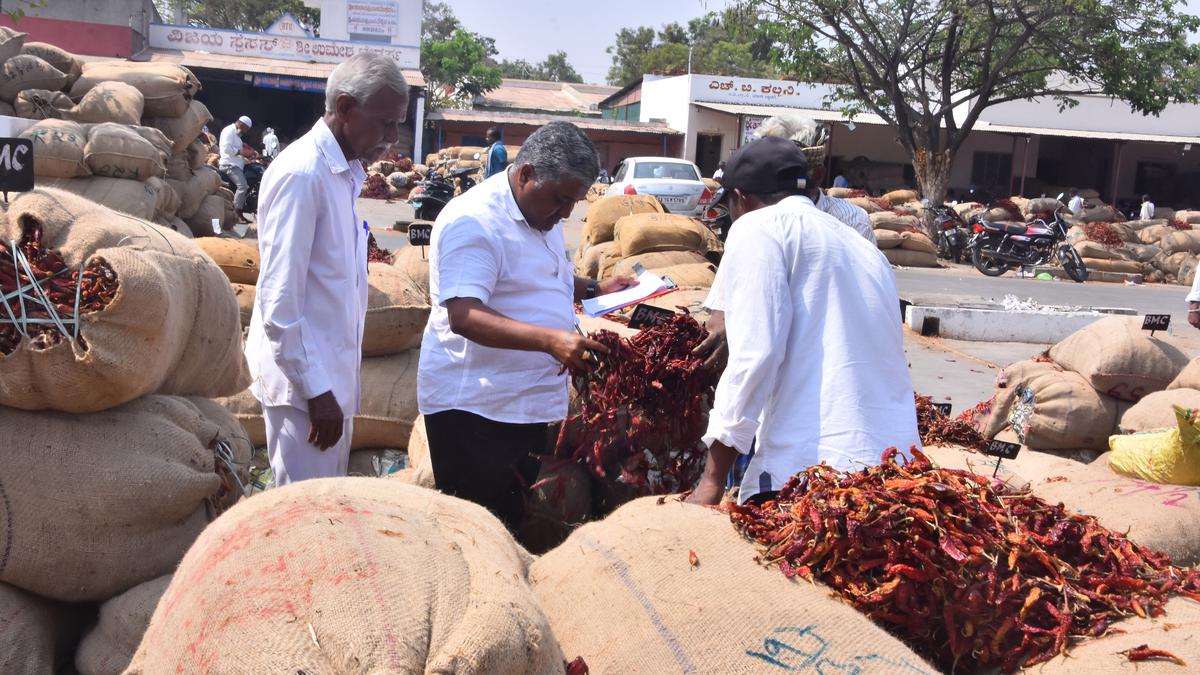
The red hot issue of Byadgi chillies Premium
The Hindu
Byadgi chilli is known for its colour and flavour, and the century-old market in the town in north Karnataka transacts massive quantities of the produce and attracts farmers from beyond the State, too.
It’s 10 a.m. on Monday, and Basavaraj Navale, who works for the commission agent Basavaraj M. Chatrad, is busy assessing the quality of the chilli kept for auction at the Agricultural Produce Market Committee (APMC) yard in Byadgi. Grabbing a handful of chilli pods from the lots containing several bags, he assesses the quality and jots down a few numbers on the notepad he is carrying while an aide opens the gunny bags to show him the pods kept for auction.
Like Basavaraj, there are scores of people with notepads going around the single commodity market yard dedicated to red dry chilli, which is spread over 78 acres in Byadgi town of Haveri district in north Karnataka. The newcomers start sneezing as they pass amid the bags, inhaling the pungent odour, while the likes of Basavaraj, accustomed to the odour, go about their work nonchalantly.
The century-old market is known for two primary varieties of chillies: the Byadgi Kaddi and Byadgi Dabbi. The Byadagi Kaddi (Capsicum annum Linn var. Acuminatum Fingerh) is known for lesser pungency and is in high demand because of its very high colour value. While these two are the original varieties for which the Byadgi market is known, the Guntur chilli and around ten other varieties with varying levels of pungency and colour value, which various seed companies have developed, are also available.
The Byadgi Kaddi and Dabbi varieties cultivated in rain-fed areas are considered to be of the highest quality and, accordingly, fetch a high price. These chilli varieties were granted the Geographical Indication (GI) tag in February 2011, with the tag number 129. Those varieties grown under irrigation fetch a lower price, and those varieties developed by seed companies fetch even less.
However, quite ironically, both these varieties, which were earlier grown in Byadgi, are no longer cultivated in the vicinity now because of low yield caused by monoculture. Now, they are cultivated in surrounding areas of Kundagol near Hubballi, Vijayapura and Bagalkot districts, all situated in north Karnataka. Ballari district, also in north Karnataka, and the border villages of Telangana and Andhra Pradesh states are the leading producers of chilli. The local farmers have mainly shifted to maize and cabbage gradually over the last two to three decades.
At a distance from the Byadgi AAPMC yard, sitting under the shade, chilli farmers are engrossed in discussion about the unprecedented violence witnessed a week ago at the same market and the subsequent loss and arrests. They turn away when they notice someone clicking photographs or making videos using a cell phone. A little later, a platoon of CRPF personnel is seen conducting a route march in a bid to reassure their safety.
“This is the first time that I have seen CRPF personnel marching in our APMC yard!” exclaims Basavaraj Chatrad, a second-generation commission agent. “We have seen protests by farmers, which were limited to burning of tyres and roadblocks. Subsequently, the committee members would intervene to hold talks, negotiate and hike prices, and the matter would end there. But this time, it was of a different scale. Never before in the history of the century-old Byadgi market have we heard of such large-scale violence,” he said, recalling the incident that occurred on March 11.













